Knotweed
Reynoutria spp.
Appearance
Three species are distinguished among the perennial knotweeds:
Japanese knotweed(Reynoutria japonica Houtt.) is a dioecious perennial up to 3 m tall with stout, glabrous, hollow stems that are usually tinged dark red. The thick rhizomes are characteristic. The plant forms numerous leaf shoots from the rhizomes. The leaves are alternate and have a family-typical ochrea (tute; membranous tube enclosing the base of the following stem limb). Leaves are broadly ovate (max. 20 cm long), narrowly acuminate at the end, and truncate at right angles or slightly rounded at the base. The inflorescences are many-flowered, the flowers small and white. The fruitlets are triangular and winged.
Sakhalin kn otweed(Reynoutria sachalinensis [F. Schmidt] Nakai) grows up to 4 m tall. Unlike Japan knotweed, the leaves are up to 30 cm tall and the leaf blade is heart-shaped rounded at the base.
The bastard knotweed (Reynoutria x bohemica Chrtek & Chrtková) occupies an intermediate position in many characteristics.

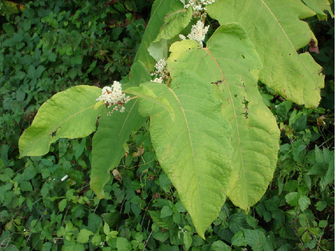
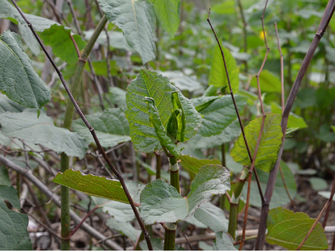
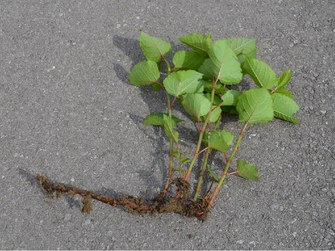
Distribution
Japan perennial knotweed and Sakhalin knotweed originate from areas in East Asia (widespread in China, Japan and Korea, Russia -Far East). Since about 1950, there has been a rapid spread in Europe. Large stands develop mainly on wood-free shorelines or under the canopy of woody plants that accompany the shore. Perennial knotweed invades herbaceous vegetation. It is also common on urban-industrial wastelands (railroads), roadsides, embankments. It grows less strongly in forests, but can also occur permanently here if there is sufficient light. Perennial knotweed is increasingly invading arable land. Perennial knotweed spreads mainly vegetatively, with rhizome fragments being carried away by flowing water or by humans.
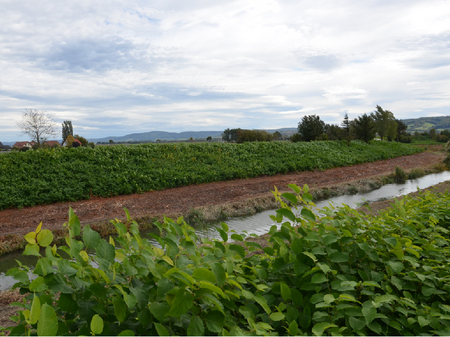
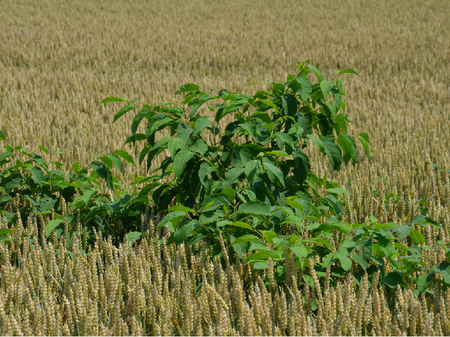
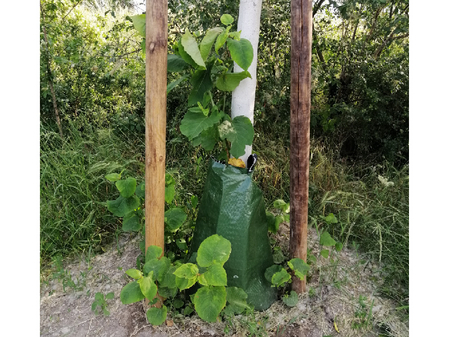
Economic importance
The economic consequences of knotweed include direct damage to buildings and bank stabilization and control costs on banks, on railway tracks and in building land, and in agriculture.
Stands on the banks of smaller streams are especially significant for conservation. Stands of knotweed are very closed and allow very limited growth of other plants. This results in alteration of the landscape and selective displacement of native species (including butterbur, stinging nettle, and fence bindweed). There is an increase in erosion hazards along riparian areas. The herbaceous knotweed dies in winter and the low fine root formation means that the soil is not adequately protected in the event of flooding.
Prevention and control
Sustainable control of knotweed is very difficult, costly and lengthy. There is also currently no consensus on the "best way" to control knotweed (see links).
- Mowing: Frequent mowing (cutting) can reduce the growth and weaken the population. However, mowing is definitely viewed critically. If mowing is done improperly, the damage is greater than the benefit - spread is encouraged. Mowing can be done in various ways and with various tools (mowers, trimmers). However, the stems must be cut cleanly (individually) and disposed of properly. Then mowing/cutting is a relatively safe and simple control option. The cuttings should be hauled away and sent to a professional composting facility (above 70°C), otherwise drying on sealed ground for several months is recommended. Several (> 4) cuts per year at a height of 40 cm over several years (at least 4) are recommended. Regular mowing is useful, for example, to ensure accessibility or visibility along a transportation infrastructure.
- Herbicides: the use of glyphosate is recommended, preferably at two dates per year (glyphosate in summer and autumn) or an annual application of glyphosate in autumn by stem injection at a dosage of 65 kg/ha or foliar spraying at a dosage of 3.6 kg/ha. However, these measures are complicated by the fact that in many habitats (e.g. along rivers) the use of glyphosate is not possible (no approval).
- Competitive vegetation: It is generally advisable to cover the ground with dense, shade-providing vegetation. Both grasses and woody plants act as competitors for perennial knotweed. In addition, this is a promising measure in combination with other methods (e.g., mowing/cutting).
- Other various measures include covering with geotextiles or geomembranes or wire netting
Links
Jones, D., Bruce, G., Fowler, MS., Law-Cooper, R., Graham, I., Abel, A., Street-Perrott, FA., Eastwood, D., 2018. Optimising physiochemical control of invasive Japanese knotweed. Biological Invasions 20, 2091-2105.
Martin, F-M., Dommanget, F., Lavallée, F., Evette, A., 2020. Clonal growth strategies of Reynoutria japonica in response to light, shade, and mowing, and perspectives for management. NeoBiota 56, 89-110.
Jones, D., Fowler, MS., Hocking, S., Eastwood, D., 2020a. Please don’t mow the Japanese knotweed! NeoBiota 60, 19-23.
Last updated: 10.09.2024
automatically translated